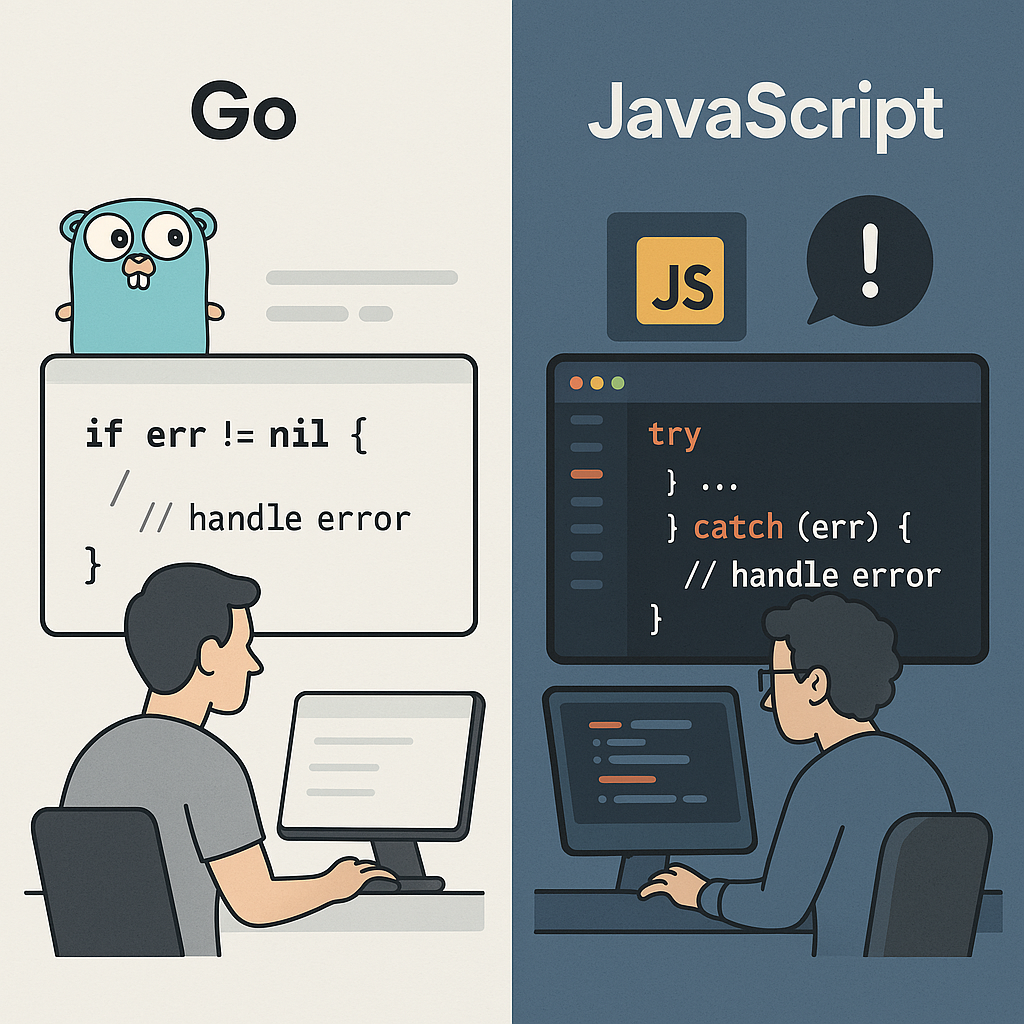Error handling is a critical aspect of programming, ensuring applications are robust and resilient to failures. Different languages adopt distinct philosophies for managing errors, shaped by their design goals and use cases. In this article, we’ll dive deep into comparing error handling in Go (Golang) and JavaScript, focusing on Go’s explicit error return approach and JavaScript’s exception-based try-catch mechanism. We’ll explore their syntax, philosophies, strengths, weaknesses, and practical implications, with examples to illustrate their differences. By the end, you’ll have a clear understanding of how these approaches suit different programming paradigms and when to leverage each.
Go’s Error Handling: Explicit and Value-Based
Go, designed for simplicity and reliability, treats errors as first-class citizens by representing them as values. Unlike languages that rely on exceptions, Go requires developers to explicitly check and handle errors, typically returned as the last value in a function’s return tuple. This approach aligns with Go’s philosophy of clarity and predictability, especially in systems programming.
Key Features of Go’s Error Handling
-
Errors as Values: Errors in Go are instances of the
errorinterface, defined as:type error interface { Error() string }Any type implementing this interface can be an error, allowing flexibility in defining custom error types.
-
Multiple Return Values: Functions that may fail typically return a result and an error, e.g.,
(value, error). If no error occurs, the error isnil. -
Explicit Checks: Developers must check errors using
if err != nil, ensuring errors are handled or propagated manually. -
No Stack Unwinding: Unlike exception-based systems, Go doesn’t automatically propagate errors up the call stack. This avoids hidden control flow but requires manual error passing.
-
Standard Library Support: Packages like
errors(for creating errors) and third-party libraries likegithub.com/pkg/errors(for stack traces) enhance error handling.
Example: Error Handling in Go
Consider a function that performs division and returns an error on division by zero:
package main
import (
"errors"
"fmt"
)
func divide(a, b int) (int, error) {
if b == 0 {
return 0, errors.New("division by zero")
}
return a / b, nil
}
func main() {
result, err := divide(10, 0)
if err != nil {
fmt.Println("Error:", err)
return
}
fmt.Println("Result:", result)
}
Output:
Error: division by zero
In this example, the divide function returns an error if b is zero. The caller checks err != nil and handles the error explicitly. If the error is nil, the result is safe to use.
Pros of Go’s Approach
- Clarity and Predictability: Errors are handled where they occur, making control flow explicit. You can trace error paths by reading the code.
- No Uncaught Errors: Explicit checks reduce the risk of ignoring errors, improving reliability in critical systems like servers or distributed systems.
- Simplicity: Errors are just values, easy to inspect, pass, or wrap with additional context (e.g., using
fmt.Errorforpkg/errors). - Performance: Checking a return value is faster than throwing and catching exceptions.
Cons of Go’s Approach
- Verbosity: Repeated
if err != nilchecks can clutter code, especially in functions with multiple error-prone operations. - Manual Propagation: Errors must be returned explicitly up the call stack, which can feel repetitive in deeply nested calls.
- No Built-in Stack Traces: The standard
errorinterface doesn’t include stack traces, requiring third-party libraries for detailed debugging. - Boilerplate Overload: Complex workflows may lead to repetitive error-handling code, though Go 1.13 introduced error wrapping (
fmt.Errorfwith%w) to mitigate this.
Error Handling in Concurrent Go Code
Go’s concurrency model (goroutines and channels) uses the same error-return pattern. For example:
func fetchData(ch chan error) {
_, err := someAsyncFunc()
ch <- err
}
func main() {
ch := make(chan error)
go fetchData(ch)
if err := <-ch; err != nil {
fmt.Println("Async error:", err)
}
}
Errors from goroutines are typically passed through channels, maintaining the explicit handling model even in concurrent contexts.
JavaScript’s Error Handling: Try-Catch and Exceptions
JavaScript, a dynamic language widely used for web development, adopts an exception-based error-handling model with try-catch. Errors are thrown as objects and propagate up the call stack until caught or the program crashes. This approach suits JavaScript’s event-driven, asynchronous nature, prioritizing developer convenience.
Key Features of JavaScript’s Error Handling
- Exception-Based: Errors are thrown using
throwand caught in atry-catchblock. Any value can be thrown, butErrorobjects are standard. - Automatic Propagation: Uncaught exceptions bubble up the call stack, potentially reaching a top-level handler or crashing the program.
- Flexible Catch Blocks: You can catch specific error types or all errors in a single block. The
finallyblock executes regardless of errors. - Stack Traces: Thrown
Errorobjects include stack traces by default, aiding debugging. - Async Integration: Try-catch works with
async/await, and Promises use.catch()for asynchronous error handling.
Example: Try-Catch in JavaScript
Here’s the division example in JavaScript:
function divide(a, b) {
if (b === 0) {
throw new Error("Division by zero");
}
return a / b;
}
try {
const result = divide(10, 0);
console.log("Result:", result);
} catch (error) {
console.log("Error:", error.message);
}
Output:
Error: Division by zero
The divide function throws an Error if b is zero. The try-catch block catches it, and the error’s message property is logged. If uncaught, the exception would propagate up, potentially crashing a Node.js process or triggering an onerror event in browsers.
Pros of JavaScript’s Approach
- Conciseness: No need to check errors at every function call; exceptions propagate automatically, reducing boilerplate.
- Centralized Handling: A single
catchblock can handle errors from multiple operations, simplifying complex workflows. - Rich Error Objects: Errors include stack traces and can be extended with custom properties or subclasses (e.g.,
TypeError,RangeError). - Async-Friendly: Try-catch integrates seamlessly with
async/await, and Promises provide.catch()for handling rejections.
Cons of JavaScript’s Approach
- Hidden Control Flow: Exceptions can make it harder to predict where errors originate or how they’re handled, especially in large codebases.
- Risk of Uncaught Errors: Developers might forget to wrap code in try-catch, leading to unhandled exceptions, particularly in async code (e.g., uncaught Promise rejections).
- Performance Overhead: Throwing and catching exceptions is slower than returning values, though this is rarely significant in typical applications.
- Overuse Potential: Developers may rely on a top-level catch-all, neglecting granular error handling.
Error Handling in Asynchronous JavaScript
JavaScript’s async code (Promises and async/await) extends try-catch. For example:
async function fetchData() {
try {
const data = await someAsyncFunc();
return data;
} catch (error) {
console.log("Async error:", error.message);
}
}
fetchData();
Alternatively, with Promises:
someAsyncFunc()
.then(data => console.log("Data:", data))
.catch(error => console.log("Async error:", error.message));
Uncaught Promise rejections can be problematic, requiring careful use of .catch() or try-catch to avoid silent failures.
Side-by-Side Comparison
| Aspect | Go (Explicit Error Handling) | JavaScript (Try-Catch) |
|---|---|---|
| Philosophy | Errors are values; handle explicitly | Errors are exceptions; handle implicitly |
| Syntax | if err != nil checks |
try { ... } catch (error) { ... } |
| Propagation | Manual (return errors up the stack) | Automatic (bubbles up until caught) |
| Stack Traces | Not included by default; needs libraries | Included by default |
| Code Clarity | Explicit, predictable, but verbose | Concise, but can obscure control flow |
| Error Types | error interface; custom types possible |
Error objects or custom subclasses |
| Use Case | Systems programming, reliability-focused apps | Web apps, rapid prototyping, async-heavy code |
| Performance | Faster (value checks) | Slower (exception handling overhead) |
| Async Handling | Channels for goroutines; same error pattern | Try-catch with async/await or .catch() |
Practical Implications and Use Cases
When to Use Go’s Error Handling
Go’s explicit error handling shines in scenarios where reliability and predictability are paramount, such as:
- Systems Programming: Building servers, databases, or CLI tools where every error must be accounted for.
- Large Codebases: Explicit checks make it easier to maintain and refactor code, as error paths are clear.
- Performance-Critical Apps: Avoiding exception overhead is beneficial in low-latency systems.
However, the verbosity can frustrate developers, especially in rapid prototyping or when handling multiple error-prone operations. Libraries like pkg/errors or Go 1.13’s error wrapping (%w) help mitigate some downsides by adding context or stack traces.
When to Use JavaScript’s Try-Catch
JavaScript’s try-catch is ideal for:
- Web Development: Building browser-based UIs or Node.js servers where rapid iteration and async operations are common.
- Prototyping: Less boilerplate speeds up development, especially in dynamic, event-driven apps.
- Complex Async Workflows: Try-catch and
.catch()simplify error handling in Promise chains or async functions.
However, developers must be disciplined to avoid unhandled exceptions, especially in async code. Tools like linters or unhandledRejection event handlers in Node.js can help catch oversights.
Hybrid Scenarios
In some cases, projects mix both languages (e.g., a Go backend with a JavaScript frontend). Here, Go’s explicit error handling ensures a robust backend, while JavaScript’s try-catch simplifies client-side logic. Developers must bridge these philosophies, often by standardizing error formats (e.g., JSON error responses) for consistency.
Best Practices
Go
- Check Every Error: Always handle errors unless you’re certain they can be ignored (rare).
- Use Error Wrapping: Leverage
fmt.Errorfwith%worpkg/errorsto add context and stack traces. - Define Custom Errors: Use structs implementing the
errorinterface for type-safe error handling. - Centralize Common Handling: Use helper functions to reduce repetitive
if err != nilblocks.
JavaScript
- Use Specific Catches: Catch specific error types when possible (e.g.,
TypeErrorvs. genericError). - Handle Async Errors: Always use
.catch()for Promises or try-catch withasync/await. - Log Stack Traces: Ensure errors are logged with stack traces for debugging.
- Avoid Catch-Alls: Don’t overuse top-level catch blocks; handle errors close to where they occur.
Conclusion
Go and JavaScript represent two ends of the error-handling spectrum. Go’s explicit, value-based approach prioritizes clarity and reliability, making it ideal for systems where errors must be meticulously managed. However, its verbosity can be a drawback in rapid development. JavaScript’s try-catch, with automatic exception propagation, offers conciseness and flexibility, suiting dynamic, async-heavy applications like web development. Yet, it risks hidden errors if not used carefully.
Choosing between them depends on your project’s needs:
- Opt for Go if you’re building a reliable, performance-critical system where explicit error paths are worth the verbosity.
- Opt for JavaScript if you need fast iteration and flexible error handling in async or UI-driven contexts.
Ultimately, both approaches are powerful within their ecosystems. By understanding their strengths and trade-offs, developers can write more robust code, whether they’re checking err != nil or wrapping code in try-catch.


